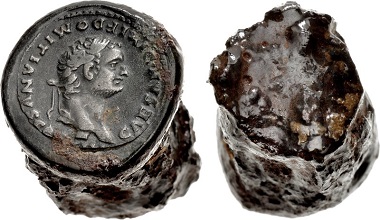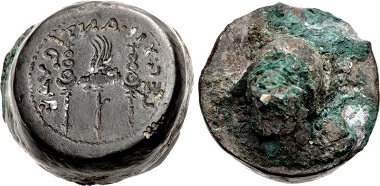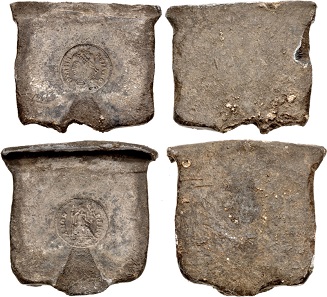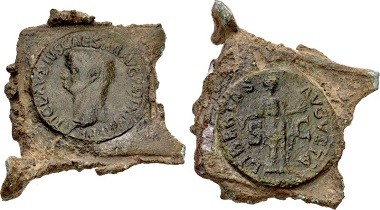11-09-2018 – 01-01-1970
CNG Auction 109: The Gasvoda Collection of Coin Dies and Counterfeiting Implements
Rare testimonies of ancient counterfeiting
For as long as there has been money, there have been counterfeiters. Contemporary counterfeit coins are frequently seen at shows and in auction listings. Many of these are quite crude in comparison to their official counterparts. Celtic imitations would fall under this category. In this case the coins were produced to facilitate trade and were accepted as such. However, there are also convincingly accurate counterfeits, which were clearly meant to deceive the recipient of such coins. In this case the clear intent was to generate profit for the counterfeiter. The later coins are usually made of base metal with only the thinnest of pure washes (silver usually) on top. It is a fairly simple task to do an online search and come up with a pretty good feel for the various types of counterfeits that were produced in antiquity.
Lot 754: Counterfeiters’ Hubs. temp. Domitian. As Caesar, AD 69-81. Bronze counterfeiter’s obverse hub for denarius set in iron shank (20x29mm, 47.43 g). Manufactured circa AD 80 or later. Dimensions: overall length, 29mm; diameter, 19 mm at face, tapering to 17mm at base. Of cylindrical form. Weight: 46.02 grams. Cast of denarius of Domitian, showing obverse with legend CAESAR DIVI F DOMITIANVS COS VII, mounted to iron shank. Cf. RIC II 266 (for coin). Good VF, some rust and deposits. Extremely rare. Estimate: $3,000.
Less frequently do we have the opportunity to examine the tools of the counterfeiter – his dies. It has been estimated that there are around 100 surviving counterfeiter’s dies from ancient times. Many of these are locked away in museums and longtime collections. Rarely do any appear at auction. CNG will offer collectors a rare opportunity to examine a large group of these dies as part of their upcoming Internet & Mail Bid Sale 109, which closes on September 12, 2018 and is now available for viewing online. It is a once in a lifetime chance to see so many dies of this type in one setting.
Lot 749: Counterfeiters’ Dies. temp. Mark Antony. Autumn 32-spring 31 BC. Brass die for AR Denarius. Legionary issue. Dimensions: overall length, 15mm; diameter, 18mm at face, expanding to approximately 22mm at base. Of cylindrical form with central tang. Weight: 22.08 grams. Brass face of cast impression of reverse of legionary denarius of Mark Antony (cf. Crawford 544/9). Cf. Crawford pp. 560-562; cf. N. Lupu, “Aspekte des Münzumlaufs im vorrömischen Dakien,” JNG XVII (1967), pl. 6; cf. C.C. Vermeule, “Some notes on ancient dies and coining methods”, NumCirc LXI.10 (November 1953), Die Representation No. 2; cf. W. Malkmus, “Addenda to Vermeule’s catalog of ancient coin dies: Part 1,? SAN XVII.4 (September 1989), p. 82. Good VF, corrosion and deposits on the reverse. Well preserved die face. Extremely rare. Estimate: $4,000.
The collection includes: two Roman Republican dies, both with exceptional die faces; a pair of imperatorial legionary denarii dies under Marc Antony, with one again having an exceptional die face; a set of dies for an Augustan as or dupondius; a Tiberius die that may be an official Roman mint die; two hubs for Domitian denarii;
Lot 757: Counterfeiters’ Molds. temp. Valens. AD 364-378. Lead Counterfeiter’s Mold for AR Siliqua. Dimensions: overall dimensions of each section, approximately 49x47x5mm with 54mm at point of connection. Total weight: 261.620 grams. Two lead plates designed for casting, each with impression of one side of a Trier mint siliqua of Valens (cf. RIC IX 27e2). Intact, earthen patina and traces of deposits. Extremely rare. Estimate: $7,500.
… a unique mold pair for a siliqua of Valens; an exceptional die for a histamenon nomisma of Romanus III Argyrus; an iron faced Celtic die; and perhaps most importantly – a die for the reverse of a Demetrios I tetradrachm that will be sold as part of the CNG Triton sale next January.
Lot 753: Counterfeiters’ Products. temp. Claudius. AD 41-54. Ancient Cast Forgery of an As (55x50mm, 34.26 g, 12h). Cast of a forger’s copy of a Rome mint Libertas reverse as of Claudius with sprue and casting flash still attached. Cf. RIC I 113 (for prototype). As made, earthen green patina. Estimate: $1,000.
Individually, the dies are all fantastic. As a group, they offer a rare look into the work of the counterfeiter during ancient times. Here can be found examples of many of the ways a forger created his counterfeits. There are: hubs that were likely used to make an impression into a sand mold before a coin was cast; obverse and reverse dies used for direct striking as would have been done with genuine coins; and a mold assembly for casting, which is particularly interesting when seen with the uncut cast counterfeit of a coin of Claudius. This latter cast is untrimmed and appears just as it would have come out of a counterfeiter’s mold.
To complete the collection, there is a nice set of dies and hubs from the Karl Goetz medal “bank fraud”. Here are found both the obverse and reverse hubs as well as the obverse and reverse dies created from the hubs. This set also includes a silver medal of the type struck from the dies as well as an oversized bronze medal of the same design.
These pieces will be offered individually in CNG’s Mail Bid Sale 109 closing on 12 September 2018.
If you wish to read a comprehensive overview on CNG’s Auction 109 please read this article.







